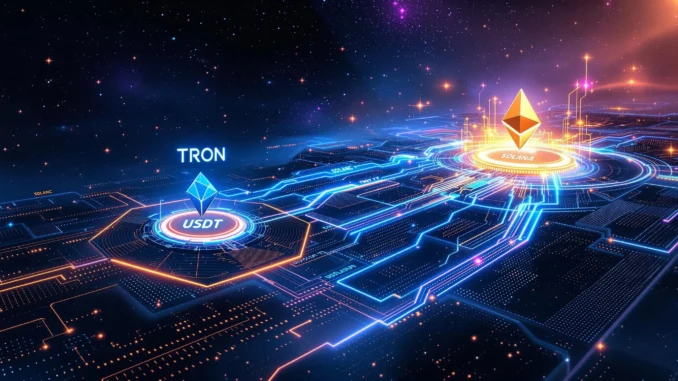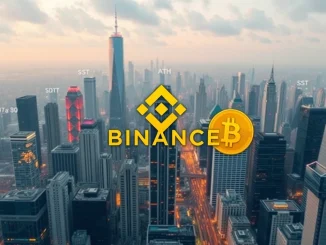
The cryptocurrency landscape is witnessing a fascinating power shift in stablecoin issuance. Forget Ethereum dominance for a moment – 2025 is shaping up to be the year of Tron and Solana when it comes to new stablecoins hitting the market. Let’s dive into the data revealed by blockchain analytics firm Spot On Chain and uncover why these networks are becoming the go-to destinations for stablecoin giants like Tether and Circle. Are you ready to explore this explosive trend in the world of stablecoins?
Why the Sudden Stablecoin Surge on Tron and Solana?
According to Spot On Chain’s recent analysis, since the dawn of 2025, a staggering three billion USDT has been issued on the Tron network by Tether. Simultaneously, Circle has minted an even more impressive 7.75 billion USDC on the Solana blockchain. This data paints a clear picture: Tron and Solana are experiencing a massive influx of new stablecoins. But what’s driving this dramatic shift away from the once-dominant Ethereum network?
Several factors could be contributing to this trend:
- Lower Transaction Fees: Both Tron and Solana are renowned for their significantly lower transaction fees compared to Ethereum. For stablecoin issuers dealing with massive volumes of transactions, these cost savings are incredibly attractive. Issuing and transferring billions of USDT or USDC becomes far more economical on these networks.
- Faster Transaction Speeds: Speed is crucial in the fast-paced crypto world. Tron and Solana boast much faster transaction processing times than Ethereum, especially the older proof-of-work Ethereum. This speed advantage is beneficial for stablecoin transactions, enabling quicker settlements and a smoother user experience.
- Growing Ecosystems: Both Tron and Solana have been actively developing and expanding their ecosystems. The increasing popularity of DeFi (Decentralized Finance) applications, NFTs (Non-Fungible Tokens), and other crypto services on these platforms is naturally driving demand for stablecoins within their respective networks.
- Strategic Focus by Issuers: Tether and Circle may be strategically diversifying their stablecoin issuance across multiple blockchains to mitigate risks and cater to different user bases. Focusing on networks like Tron and Solana allows them to tap into specific markets and communities.
The Rise of USDT on the Tron Network
Tron has long been a popular choice for USDT, and this trend is clearly accelerating in 2025. The network’s low fees and fast transactions make it particularly appealing for users in regions where transaction costs are a significant concern. Furthermore, Tron’s ecosystem has fostered a strong community, particularly in Asia, where USDT adoption is widespread. The issuance of three billion USDT on Tron in just a few months of 2025 highlights the network’s continued dominance in this area.

Benefits of USDT on Tron:
- Cost-Effective Transactions: Significantly lower fees compared to Ethereum.
- Fast Transfers: Quick transaction confirmations.
- Accessibility: Widespread adoption and accessibility, especially in emerging markets.
- Mature Ecosystem: Established infrastructure and a thriving community.
USDC’s Solana Surge: A New Frontier for Stablecoins
While Tron has been a long-time player in the stablecoin space, Solana’s emergence as a major hub for USDC is a more recent and noteworthy development. The issuance of a massive 7.75 billion USDC on Solana in 2025 underscores the network’s growing influence and appeal. Solana’s technological capabilities, characterized by incredibly high transaction speeds and low fees, are undoubtedly attracting Circle and its USDC stablecoin.

Advantages of USDC on Solana:
- Ultra-Fast Transactions: Among the fastest transaction speeds in the blockchain space.
- Scalability: Designed to handle a high volume of transactions.
- Low Fees: Extremely competitive transaction costs.
- Developer-Friendly: Attracting a growing number of DeFi and NFT projects.
Ethereum’s Minimal Stablecoin Issuance: Is the King Losing its Crown?
The data from Spot On Chain highlights a stark contrast: direct issuance of stablecoins on the Ethereum network has been minimal during this period. Does this mean Ethereum is losing its dominance in the stablecoin market? Not necessarily. While direct issuance might be lower, Ethereum still holds a significant portion of the overall stablecoin supply and remains the leading platform for DeFi and many other crypto applications.
However, the minimal direct issuance does signal a shift in strategy. Issuers like Tether and Circle might be leveraging Tron and Solana for new issuance to capitalize on their advantages, while Ethereum remains more of a reserve and settlement layer for larger transactions and complex DeFi operations. Ethereum’s transition to Proof-of-Stake (PoS) with the Merge and subsequent upgrades aim to address scalability and cost issues, which could potentially attract more stablecoin issuance in the future.
What Does This Stablecoin Trend Mean for the Future?
The increasing stablecoin issuance on Tron and Solana signifies a maturing and diversifying cryptocurrency ecosystem. It demonstrates that users and issuers are actively seeking out blockchains that offer specific advantages in terms of speed, cost, and scalability. This trend could lead to:
- Increased Competition: More blockchains vying for stablecoin dominance, potentially benefiting users with lower fees and faster transactions across the board.
- Ecosystem Growth: The influx of stablecoins can fuel further growth within the Tron and Solana ecosystems, attracting more developers and users.
- Multi-Chain Future: The crypto landscape may evolve into a more multi-chain environment, where different blockchains specialize in various applications and use cases, with stablecoins playing a crucial role in interoperability.
Conclusion: Embracing the Multi-Chain Stablecoin World
The data is clear: 2025 is witnessing a significant shift in stablecoin issuance, with Tron and Solana emerging as major players. While Ethereum remains a critical part of the crypto ecosystem, the rise of these alternative networks highlights the dynamic and evolving nature of the blockchain space. As users and issuers continue to prioritize efficiency and cost-effectiveness, we can expect to see further innovation and competition in the stablecoin arena, paving the way for a more robust and accessible financial future. Keep an eye on Tron and Solana – their stablecoin surge is just getting started!



